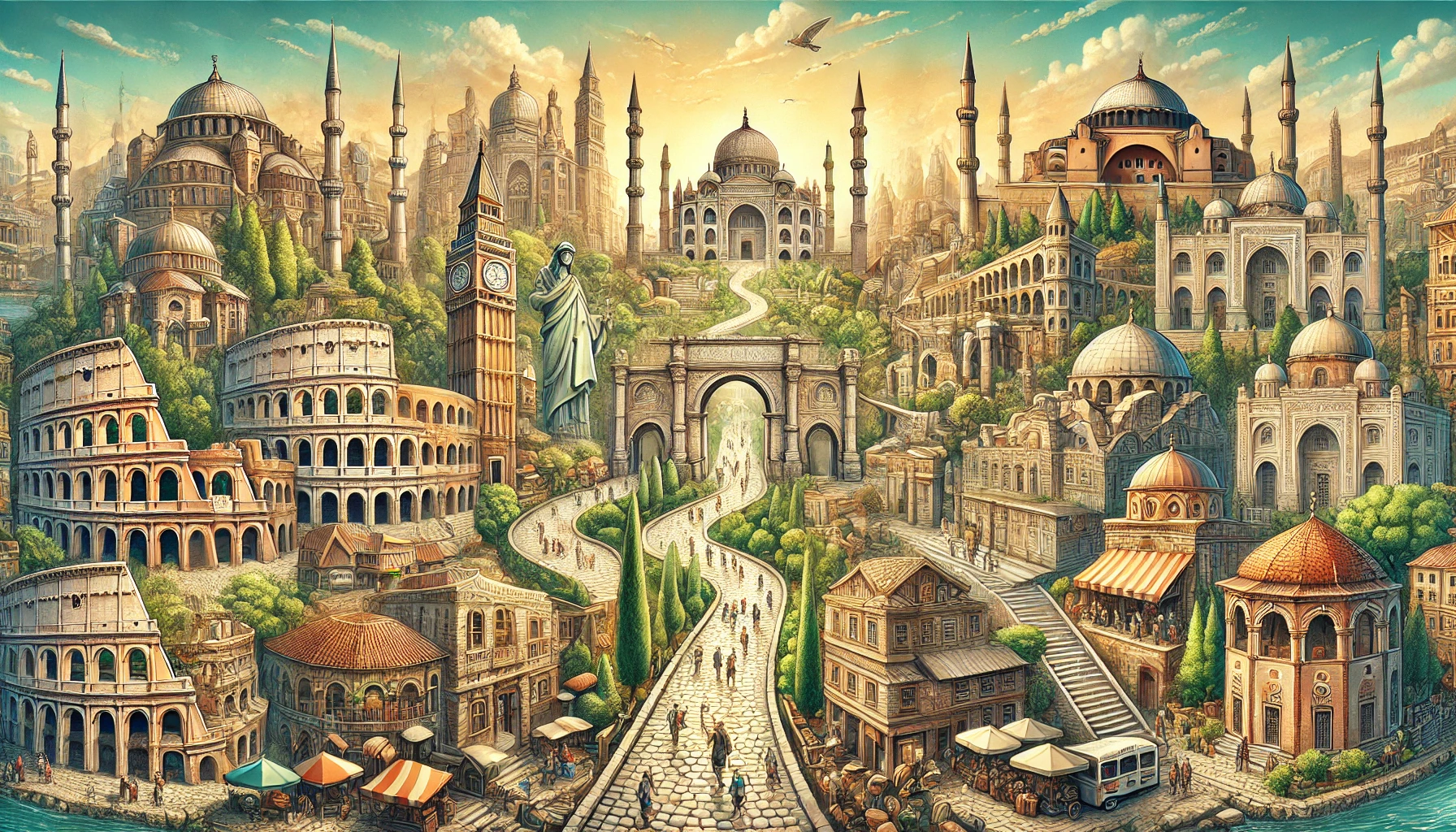History shapes the essence of cities, turning them into vibrant museums where every corner tells a tale from the past. From ancient ruins and medieval castles to streets that have seen revolutions, historic cities allow travelers to experience different eras. Each city offers a unique story, showcasing the culture, traditions, and events that have influenced the world.
Why Visit Historic Cities?
Traveling to historic cities goes beyond sightseeing; it offers a chance to:
- Connect with the Past: Discover the legacies of ancient civilizations and historic events.
- Understand Cultural Roots: Learn about the traditions and customs that define a region.
- Preserve History: Help maintain and protect heritage sites for future generations.
Iconic Historic Cities Around the World
1. Rome, Italy: The Eternal City
Rome exemplifies the grandeur of the Roman Empire, the impact of the Renaissance, and the endurance of cultural heritage.
Iconic Landmarks:
- Colosseum: Symbol of Roman engineering, once hosting gladiator battles.
- Pantheon: Ancient architectural marvel known for its massive dome.
- Roman Forum: The political and social hub of ancient Rome.
The Story It Tells: Rome’s layers reveal its transformation from a republic to an empire and its lasting significance in art, religion, and power.
2. Kyoto, Japan: The Cultural Heart of Japan
Kyoto, the former imperial capital, offers a peaceful journey through Japan’s feudal era and spiritual traditions.
Iconic Landmarks:
- Kinkaku-ji (Golden Pavilion): A Zen Buddhist temple adorned in gold leaf, showcasing Japanese artistry.
- Fushimi Inari Shrine: Famous for its thousands of red torii gates.
- Gion District: Preserving traditional wooden houses and geisha culture.
The Story It Tells: Kyoto embodies Japan’s dedication to beauty, harmony, and spirituality, providing insights into samurai culture and ancient rituals.
3. Cairo, Egypt: The Gateway to Ancient Wonders
Cairo bridges the modern world with the timeless mysteries of ancient Egypt.
Iconic Landmarks:
- Pyramids of Giza: The last remaining wonder of the ancient world.
- Egyptian Museum: Houses artifacts from the age of the pharaohs, including Tutankhamun’s treasures.
- Islamic Cairo: A maze of mosques, bazaars, and historic buildings showcasing Islamic art.
The Story It Tells: Cairo narrates humanity’s ingenuity and resilience, from the pyramids’ construction to the rise of Islamic civilization.
4. Athens, Greece: The Cradle of Democracy
Athens stands as a symbol of Western civilization, where philosophy, democracy, and art thrived.
Iconic Landmarks:
- Acropolis: Home to the Parthenon, representing ancient Greek ideals.
- Ancient Agora: Birthplace of democratic principles.
- Plaka District: A charming neighborhood with neoclassical architecture and narrow streets.
The Story It Tells: Athens invites travelers to explore the intellectual and artistic achievements that shaped the modern world.
5. Istanbul, Turkey: Where East Meets West
Istanbul, straddling Europe and Asia, is a city of contrasts, shaped by empires and cultural exchanges.
Iconic Landmarks:
- Hagia Sophia: A masterpiece of Byzantine and Ottoman architecture, transitioning from a church to a mosque and now a museum.
- Topkapi Palace: The luxurious residence of Ottoman sultans.
- Grand Bazaar: One of the world’s oldest and largest covered markets.
The Story It Tells: Istanbul’s rich history reflects its role as a crossroads of trade, culture, and empires.
Conclusion
These historic cities offer more than just a glimpse into the past. They provide a deeper understanding of different cultures, traditions, and human achievements. Visiting these places allows us to appreciate the legacy left behind and the importance of preserving it for future generations.
Cusco, Peru: The Heart of the Inca Empire
Cusco, formerly the hub of the Inca Empire, serves as an entrance to the wonders of ancient civilizations in pre-Columbian times.
Iconic Landmarks:
- Sacsayhuamán: An impressive fortress with colossal stone walls, illustrating Inca architectural prowess.
- Qorikancha: A historic Inca temple topped with a Spanish church, representing colonial encounters.
- San Pedro Market: A lively place to experience local traditions and food.
The Story It Tells:
Cusco showcases the brilliance of the Incas and the blend of cultures that emerged after the Spanish conquest.
Jerusalem, Israel: A Spiritual Epicenter
Jerusalem holds sacred significance for Judaism, Christianity, and Islam, each religion leaving a lasting imprint on its landscape.
Iconic Landmarks:
- Western Wall: A revered site for Jewish prayer and pilgrimage.
- Church of the Holy Sepulchre: Thought to be the location of Jesus’ crucifixion and resurrection.
- Dome of the Rock: An Islamic shrine with deep religious importance.
The Story It Tells:
Jerusalem’s past is a rich tapestry of faith, strife, and endurance, offering profound spiritual insights.
Preserving Historic Cities
Historic cities encounter challenges like urban growth, climate change, and heavy tourism. Protecting their heritage is crucial.
Strategies for Preservation:
- Sustainable Tourism: Promote travel practices that reduce environmental harm.
- Restoration Projects: Fund efforts to maintain and refurbish historic sites.
- Community Engagement: Involve locals in conservation to ensure lasting preservation.
Tips for Exploring Historic Cities
- Do Your Research: Understanding the city’s history and landmarks enhances your visit.
- Hire Local Guides: They can offer in-depth knowledge and stories.
- Respect Local Customs: Be aware of cultural and religious practices, especially at sacred places.
- Travel Off-Season: Avoiding peak times provides a more personal experience.
- Take Your Time: Explore at a relaxed pace to fully absorb the atmosphere.
Conclusion
Historic cities act as time capsules, capturing the essence of ancient civilizations and offering insights into our shared heritage. Whether wandering through Rome’s ruins, admiring the Pyramids of Giza, or exploring the bustling streets of Istanbul, each city has its own unique tale. Traveling through these places is not just a physical journey but a passage through time, connecting us to the people, events, and cultures that have shaped our world.



